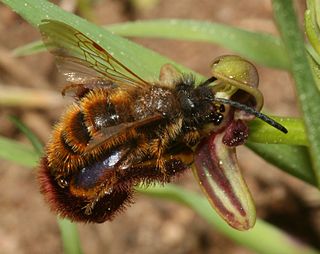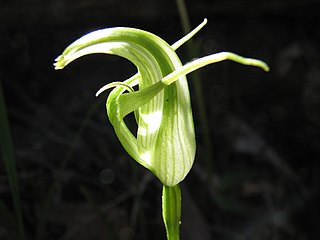
Hoverflies, also called flower flies or syrphids, make up the insect family Syrphidae. As their common name suggests, they are often seen hovering or nectaring at flowers; the adults of many species feed mainly on nectar and pollen, while the larvae (maggots) eat a wide range of foods. In some species, the larvae are saprotrophs, eating decaying plant and animal matter in the soil or in ponds and streams. In other species, the larvae are insectivores, preying on aphids, thrips, and other plant-sucking insects.

In evolutionary biology, mimicry is an evolved resemblance between an organism and another object, often an organism of another species. Mimicry may evolve between different species, or between individuals of the same species. In the simplest case, as in Batesian mimicry, a mimic resembles a model, so as to deceive a dupe, all three being of different species. A Batesian mimic, such as a hoverfly, is harmless, while its model, such as a wasp, is harmful, and is avoided by the dupe, such as an insect-eating bird. Birds hunt by sight, so the mimicry in that case is visual, but in other cases mimicry may make use of any of the senses. Most types of mimicry, including Batesian, are deceptive, as the mimics are not harmful, but Müllerian mimicry, where different harmful species resemble each other, is honest, as when species of wasps and of bees all have genuinely aposematic warning coloration. More complex types may be bipolar, involving only two species, such as when the model and the dupe are the same; this occurs for example in aggressive mimicry, where a predator in wolf-in-sheep's-clothing style resembles its prey, allowing it to hunt undetected. Mimicry is not limited to animals; in Pouyannian mimicry, an orchid flower is the mimic, resembling a female bee, its model; the dupe is the male bee of the same species, which tries to copulate with the flower, enabling it to transfer pollen, so the mimicry is again bipolar. In automimicry, another bipolar system, model and mimic are the same, as when blue lycaenid butterflies have 'tails' or eyespots on their wings that mimic their own heads, misdirecting predator dupes to strike harmlessly. Many other types of mimicry exist.

Disa is a genus of flowering plants in the family Orchidaceae. It comprises about 182 species. Most of the species are indigenous to tropical and southern Africa, with a few more in the Arabian Peninsula, Madagascar, and Réunion. Disa bracteata is naturalised in Western Australia, where the local name is "African weed-orchid."

Ophrys insectifera, the fly orchid, is a species of orchid and the type species of the genus Ophrys. It is remarkable as an example of the use of sexually deceptive pollination and floral mimicry, as well as a highly selective and highly evolved plant–pollinator relationship.

Dactylorhiza viridis, the frog orchid, is a species of flowering plant in the orchid family Orchidaceae. It has also been treated as the only species Coeloglossum viride of the monotypic genus Coeloglossum.

Epidendrum radicans is a species of orchid native to Central America and northern South America. Common names include ground-rooting epidendrum, fire-star orchid, crucifix orchid, rainbow orchid, and reed-stem epidendrum.

Neotinea ustulata, the burnt orchid or burnt-tip orchid, is a European terrestrial orchid native to mountains in central and southern Europe, growing at up to 2,400 m (7,900 ft) elevation. The plant is considered Endangered in Great Britain and Least Concern internationally based on IUCN Red List criteria. The burnt-tip orchid was voted the county flower of Wiltshire in 2002 following a poll by the wild flora conservation charity Plantlife.

Boquila is a genus of flowering plants in the family Lardizabalaceae, endemic to temperate forests of central and southern Chile and Argentina. It is monotypic, being represented by the single species Boquila trifoliolata, locally known as voqui blanco or pilpil in its native range, and sometimes referred as the chameleon vine since a recent report on leaf mimicry. The species was first described in 1782 by Juan Ignacio Molina, and the genus itself was established in 1839 by Joseph Decaisne. B. trifoliata forms non-parasitic vines that wind around host plants, using them for structure and protection. B. trifoliata is monoecious, and its flowers are an off white color. It bears an edible fruit and has been historically used in rope and basket making.

Platanthera chlorantha, commonly known as greater butterfly-orchid, is a species of orchid in the genus Platanthera. It can be found throughout Europe and Morocco. The name Platanthera is derived from Greek, meaning "broad anthers", while the species name, chlorantha, means "green-flowered".

Pouyannian mimicry is a form of mimicry in plants that deceives an insect into attempting to copulate with a flower. The flower mimics a potential female mate of a male insect, which then serves the plant as a pollinator. The mechanism is named after the French lawyer and amateur botanist Maurice-Alexandre Pouyanne. The resemblance that he noted is visual, but the key stimuli that deceive the pollinator are often chemical and tactile.

Disa uniflora, the red disa or pride of Table Mountain, is a South African species of orchid in the family Orchidaceae. It is the type species of the genus Disa, and one of its best-known members. It is occasionally referred to by its old name Disa grandiflora.

Disa bracteata, also known as the bract disa, leek orchid or the South African weed orchid is a species of orchid native to South Africa.

Chemical mimicry is a type of biological mimicry involving the use of chemicals to dupe an operator.

Aeropetes is a monotypic butterfly genus in the family Nymphalidae. Its only species, Aeropetes tulbaghia, is commonly known as the Table Mountain beauty or mountain pride. It is native to southern Africa, where it occurs in South Africa, Lesotho, Eswatini and Zimbabwe.

Pterostylis alpina, commonly known as the mountain greenhood, is a species of orchid endemic to south-eastern Australia. It has a rosette of fleshy leaves at the base and usually only one white flower with green markings and back-swept lateral sepals.

In evolutionary biology, mimicry in plants is where a plant evolves to resemble another organism physically or chemically. Mimicry in plants has been studied far less than mimicry in animals. It may provide protection against herbivory, or may deceptively encourage mutualists, like pollinators, to provide a service without offering a reward in return.

Pterostylis diminuta, commonly known as the small-flowered leafy greenhood, is a plant in the orchid family Orchidaceae and is endemic to Victoria. As with similar greenhoods, the flowering plants differ from those that are not flowering. The non-flowering plants have a rosette of leaves flat on the ground but the flowering plants have up to twelve small, partly green, partly translucent flowers and lack a rosette.
Pterostylis aquilonia, commonly known as the northern cobra greenhood, is a species of orchid endemic to Queensland. As with similar orchids, the flowering plants differ from those which are not flowering. The non-flowering plants have a rosette of leaves, but the flowering plants lack a rosette and have a single flower with leaves on the flowering spike. This greenhood has a relatively large green, white and reddish-brown self-pollinating flower.

Pterostylis cardiostigma is a species of orchid endemic to New Zealand. It has erect leaves, the upper leaves higher than the flower which is stiff, upright and green with narrow white stripes and pinkish tips. It barely opens fully and is sometimes mistaken for an unopened flower of Pterostylis banksii with which it often grows.

The pollination of orchids represents a complex aspect of the biology of this plant family, characterized by intricate flower structures and diverse ecological interactions with pollinator. Notably, the topic has garnered significant scientific interest over time, including the attention of Charles Darwin, who is recognized for his contributions to the theory of evolution by natural selection. In 1862, Darwin published his observations on the essential role of insects in orchid pollination in his work The Fertilization of Orchids. He noted that the various strategies employed by orchids to attract their pollinators are complex.


























